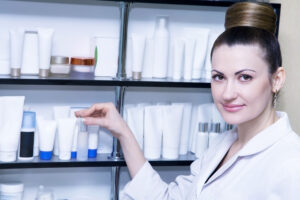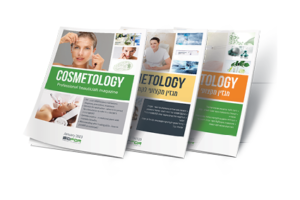Being a wise consumer of products and professional information – Separating the wheat from the chaff
Our current era is one in which science provides us with abundant tools and essential knowledge. We can utilize this knowledge to treat skin and improve our success (and profitability). On the other hand, the multitude of slogans, promises, and erroneous information lead to a large amount of confusion. This situation is becoming increasingly more complex with each passing year, with the introduction of new devices, technologies, and treatment series that boast “cutting edge” ingredients. How can we navigate this sea of information without getting lost?

Treating skin and improving its appearance and function is one of the most fascinating fields there is. It is a huge challenge to transform aging, tired, and dull skin into healthy and radiant skin, or turn acne-prone skin into smooth and beautiful skin. The cosmetics industry of a decade ago has changed beyond recognition and it now sets its sights higher. What makes it possible for cosmetic products to be more specialized, therapeutic, and powerful is the immense knowledge that research institutions around the world have amassed. Such knowledge includes: How to influence the appearance and function of the skin; What Vitamin C derivatives (for example) are available to us for topical application, what are the advantages and disadvantages of each, what concentration will we use in each, and how can we stabilize them in a cream? What combinations of active ingredients are synergistic and intensify each ingredient’s action? What other capabilities do ingredients that we are already familiar with have? What effect does the medical/cosmetic device (IPL, RF, HIFU etc.) have on the skin, and how? What medical procedures (Microneedling, Different types of peeling, etc.) generate which effect and what cases are they suited to? And much more.
This immense knowledge is available as scientific articles in professional scientific journals. It turns out that cosmetology interests scientists around the world no less than other medical fields. Thousands of universities and prestigious faculties throughout the world publish interesting studies about the effects of active ingredients (many of which are found in cosmetic products), aesthetic skin conditions, medical and cosmetic devices (like for hair removal, skin renewal, acne and pigmentation treatment), about the skin’s permeability to active ingredients, and about anti-aging. As potential consumers of the knowledge and as important users of it, it’s important that you know how scientific material is created and published, unlike articles in other media.

Sample journals in the field of cosmetic dermatology and associated topics
- Journal of Cosmetic Dermatology
- International Journal of Cosmetic Science
- Journal of Applied Cosmetology
- Journal of Cosmetic Science
- Journal of Cosmetics, Dermatological Sciences and Applications
How scientific information is created and published
What is the difference between scientific publication in a scientific journal (and there are dozens of these in the fields of cosmetology, dermatology, and similar fields) and an article that you read in the press or online? Scientific journals do not accept every article for publishing. The researcher authoring the article, who often worked for years on their research study and arrived at some finding, sends the article to the journal’s editorial board. The article is always written in standard format – Introduction, Tools, Methods, Findings organized in tables and graphs and a discussion of them, with bibliographic references, etc. The article is sent by the journal’s editor, a scientist him/herself, to three known experts in this field for a peer review – does the article indeed meet the requirements, prove what it purported to prove, is free of errors and fit for publication as a new scientific finding. Sometimes these experts make comments or request additional checks by the author of the article. The author conducts the necessary checks or changes and sends an amended version back to the journal aditor. The aim of all these stringent checks is to eventually produce an article with value – one that other scientists/experts can learn from. Think about your doctor, who completed med school around 10 years ago. His area of expertise has undergone numerous changes since then, and he has to stay abreast of these developments. Doctors, researchers, and scientists stay abreast of updates and developments through scientific publications that appear (among other places) in these journals. Therefore, they must provide pure science, reliable information that can be used to make decisions. Of course, there are scientific journals that are considered more prestigious or less prestigious, with more or less scholarly peer review, but in general – these journals are meant for medical and science professionals, are written by researchers, and they are the source for the most current information in every field. The journals are in English and written in professional jargon, understandable to academically trained medical/biology/biochemistry professionals. And they are all accessible mainly through PubMed, a website where science professionals search for knowledge in specific fields. PubMed is like Google for scientists.
How this information gets to us
Somehow, this science has not yet been translated into knowledge that can serve the wise cosmetologist, and all the “information” (articles online and in the press, tutorials and courses taught by cosmetologists) that does make it to the cosmetologist – is tainted with so many errors and falsities. This creates a true disconnect between the immense, empowering, objective, and important knowledge – and what the cosmetologist actually knows in practice. This disconnect also results in you, as consumers of various publications, to believe promises that are false or that you cannot verify due to lack of tools. It’s unpleasant to read and accept this, but it’s important to face the facts. The change always starts with the acknowledgement that something is not satisfactory.
My goal in this long-winded introduction is to make you realize that in your occupation there is an overload of information that is scientifically inaccurate, and on the other hand there is a lot to know that can change how you work. With a change in approach you can change the existing situation for everybody’s benefit. A change in approach means asking the right questions and demanding the specific knowledge that is important to you from the sales rep. Don’t settle for less and don’t believe anyone that tells you that the answer is too “complicated” to explain to you.
What questions to ask
You can start generating a change in the cosmetology industry by getting into the habit of asking questions. The more focused and informed the questions you ask will be, the more the sales reps will need to provide you with satisfactory answers. Every topic can be explained to you – the buyers, in a language you can understand. Let’s take for example the device used to “deliver substances” through the skin, like ultrasound. Can anyone of you who have purchased the device answer the following questions: What is the maximum molecule size that can penetrate the skin by using the device? What is the molecular size of the substances you are attempting to deliver using the device? Would they permeate the skin regardless? Is their molecular structure preserved also under the influence of the ultrasound waves, which are known to break down certain substances? Do you know how deep in the skin the substances reach and how much of the injected amount penetrates the bloodstream? And what is the significance of the arrival of these components in the bloodstream? Is there meaning and benefit in the one-time administration of these ingredients? After all, you don’t perform cosmetic treatment every day, but every two or three months or more. And the ultimate question: Do you have access to a study that demonstrates the improvement in the skin as a result of delivering substances using this technology? And a question to the cosmetologist: Do you also use it to deliver moisturizing creams or any basic cream that contains preservatives, stabilizers, artificial colors or fragrances, and any other substance that we don’t want to permeate deep into the skin? Another example is the devices that “deliver oxygen to the skin”: Has anyone asked to see the scientific literature that proves that oxygen treatments improve the skin’s appearance? (This refers to “oxygen diffusion to cells” and not to spraying, which causes exfoliation: exfoliation can be done with a variety of simple methods). The facts are that there is not one scientific article that proves that a cosmetic treatment based on “delivers oxygen to the skin” changed the skin’s appearance, or its oxygen content. And remember that active ingredients do not permeate the skin in a gaseous phase. (Treating diabetes lesions with oxygen has been documented in the literature, but it does not belong to the category of beauty treatments on healthy skin). Also using ultrasound, or electroporation to deliver cosmetic ingredients to the skin has not been described in any study. This is in contrast to tens, hundreds, and sometimes even thousands of scientific articles documenting the effect of each and every one of the other established anti-aging agents. The fact that you don’t ask for scientific references for the action of ingredients or devices, will result in increasingly more promises and devices being introduced in the future, which are not proven to be effective, and you will willingly buy them. On the other hand, if you insist on obtaining a reference for every promise made to you, you will lead a process of introducing integrity, reliability, and truth to the field of cosmetology. You will also be separating the wheat from the chaff, and causing the tools with the power to change to prevail.
Scientific sounding words
The situation is not that different in the world of cosmetic creams. Recent years have heralded a “scientific approach” to the world of cosmetology, and many instructors use scientific terms in a way that indicates a lack of understanding. One of the terms in the industry is “nanotechnology creams”.

This is an impressive term that in most cases the sales rep cannot really explain to you. Have you ever asked the sales rep what they mean by this term? What has actually been made smaller, what was its size previously, how was it made smaller, and what exactly is done with the nanotechnology? And another impressive and contemporary term: biotechnology cream. First let’s explain the term: Biotechnology means applied biology. Numerous uses of biology fall under this umbrella term. Now, check with the sales rep: What biotechnology process was applied to the cream or one of its ingredients? Does this process give the cream or an ingredient an advantage compared to another similar cream without biotechnology (or compared to the same ingredient that was produced without biotechnology?). What is the practical significance, for you as practitioners, of the biotechnology in this product? As a researcher of active ingredients and their effect on the skin, I would like to share with you the following distinction: the more active the product, the less need there will be for impressive terms to describe it. Moreover: The truly active ingredients are simple and familiar ingredients that do not need to be reduced with nanotechnology, there is no need to produce them with biotechnology, and in general, they sound very simple and real. Their action can be explained in layman’s terms. And the fact that they do indeed work saves the manufacturer the effort of trying to impress. He just gives a sample and you experience the results.
Busting a few myths
Let’s explore a few ingrained beliefs and see which questions we should ask about them. Eye cream is a staple cosmetic, a favorite among cosmetologists and customers alike. The fact is, that if there is no difference between the eye area and the rest of the face, a good (and unscented) moisturizing cream can be used over the entire face. Has anyone ever asked the sales rep what the difference is between their eye cream and moisturizing cream? If the only difference is that the eye cream is unscented and has a richer texture, then choose a rich and unscented moisturizing cream. It’s much more cost-effective. Did you check, before choosing the eye cream, that it contains unique ingredients to treat the eye area and whether these ingredients were found to be active in improving parameters of the eye area? (By the way, one way of checking the efficacy of an eye cream is to apply the eye cream to one eye and moisturizing cream to the other eye, and see whether there’s a difference in the sides). Of course I don’t claim that no eye cream is worth buying. I suggest that you decide on your objective before buying – what did you hope to solve/change using the eye cream and then – can the eye cream offered to you meet these expectations. Tests that were conducted to the eye creams of several manufacturers showed that their ingredients are identical to those in their moisturizing cream. However, there are of course eye creams with unique ingredients, that justify purchasing them. Another topic that causes confusion is impressive names of ingredients that cannot permeate the skin, like: DNA, collagen, elastin, stem cells , hyaluronic acid, etc. And there are ingredients that offer no benefit when applied to the skin, such as gold, pearls, diamonds, caviar. DNA and stem cells, which appeared in the first category of ingredients (impermeable to skin) also belongs to the second category: We won’t benefit from it even if we inject it into the skin. This is a simple biological truth that every science student knows, but is neglected (or unfamiliar) in our industry, by both the sellers and the buyers.
Summary
Your success in the profession depends on your approach and also on effective tools at your disposal. How will you obtain the products and instruments important to your success, without getting lost among all the choices? Start by adopting a clearheaded, inquisitive, and somewhat skeptical approach. There are numerous materials and methods that can help you achieve your goals. But there are many more that are a heavy financial burden that does not lead to any therapeutic result. If you become accustomed to asking all the questions, you will lead, separately and collectively, to a situation where the industry will provide you with matter-of-fact answers rather than impressive and scientifically baseless declarations. If you hone your ability to choose, you will achieve good therapeutic results, more satisfaction from the work, and greater financial success. There is a parable about one wise man who was traveling through the forest and saw a sweaty woodcutter struggling to chop wood. “How long have you been trying to cut down this tree?”, asked the wise man. “Since the morning”, answered the man, straining to breathe and wiping his sweaty brow. “Can I make a suggestion?” The wise man said, “I see that your axe is blunt. You can sharpen it and then you won’t have to work as hard and it won’t take you as long…” – “I don’t have time for that”, retorted the woodcutter, “I have to get back to work. I have to finish cutting down this tree”.
I welcome you to consider the option of sharpening the axe – your intellectual ability as practitioners to correctly choose, decide, weigh, and navigate. You’ll achieve more with a sharp axe and with less effort (or financial investment), and more efficiently. Any such investment, as far as you are concerned, translates into professional success, greater satisfaction, and will be more financially rewarding.
